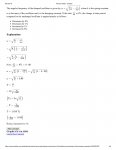You are using an out of date browser. It may not display this or other websites correctly.
You should upgrade or use an alternative browser.
You should upgrade or use an alternative browser.
How to calculate w = root (K/m) - (r^2/4m^2)?
- Thread starter Indranil
- Start date
mmm4444bot
Super Moderator
- Joined
- Oct 6, 2005
- Messages
- 10,962
In the second step, they factored out K.… I don't understand the second and the third steps.
In the third step, they factored out 1/m.
Do you need help finding online lessons, to learn how to factor?
This is not correct. You need to use proper grouping symbols, to show the correct order of operations. Your typing actually means this:w = root (K/m) - (r^2/4m^2)
\(\displaystyle w = \sqrt{\dfrac{K}{m}} - \dfrac{r^{2}}{4} \cdot m^{2}\)
The correct notation is:
w = sqrt[K/m - r^2/(4m^2)]
Dr.Peterson
Elite Member
- Joined
- Nov 12, 2017
- Messages
- 16,749
How to calculate w = root (K/m) - (r^2/4m^2)? Here I don't understand the second and the third steps. Could you simplify the steps for me, please?
First, let's be sure to write it correctly; they are staring with sqrt[(K/m) - (r^2)/(4m^2)], where the bar over the radicand has to be replaced with some sort of bracket when we write inline. And we need parentheses around the denominator to make sure that is multiplied first.
Now, the first couple steps are factoring K/m out of the radicand. Here is one way you might think about it (doing it all in one, rather than first factoring out K and then 1/m as they do); a key step is to recognize that multiplying by K/m and also by its reciprocal leaves the value unchanged:
K/m - (r^2)/(4m^2) = (K/m)*1 - (K/m)*(m/K)*(r^2)/(4m^2) [here I rewrote each term with (K/m) as a factor]
= (K/m)[1 - (m/K)(r^2)/(4m^2)] [here I factored out the common factor]
= (K/m)[1 - (1/K)(r^2)/(4m)] [here I canceled an m]
= (K/m)[1 - (r^2)/(4mK)] [here I multiplied the denominators]
Then they can use the fact that (r^2)/(mK) = 0.08.
Last edited by a moderator:
Could you suggest me how to write the proper symbols because the keyboard does not have any scientific symbols?In the second step, they factored out K.
In the third step, they factored out 1/m.
Do you need help finding online lessons, to learn how to factor?
This is not correct. You need to use proper grouping symbols, to show the correct order of operations. Your typing actually means this:
\(\displaystyle w = \sqrt{\dfrac{K}{m}} - \dfrac{r^{2}}{4} \cdot m^{2}\)
The correct notation is:
w = sqrt[K/m - r^2/(4m^2)]
Could you simplify this step, please?First, let's be sure to write it correctly; they are staring with sqrt[(K/m) - (r^2)/(4m^2)], where the bar over the radicand has to be replaced with some sort of bracket when we write inline. And we need parentheses around the denominator to make sure that is multiplied first.
Now, the first couple steps are factoring K/m out of the radicand. Here is one way you might think about it (doing it all in one, rather than first factoring out K and then 1/m as they do); a key step is to recognize that multiplying by K/m and also by its reciprocal leaves the value unchanged:
K/m - (r^2)/(4m^2) = (K/m)*1 - (K/m)*(m/K)*(r^2)/(4m^2) [here I rewrote each term with (K/m) as a factor]
= (K/m)[1 - (m/K)(r^2)/(4m^2)] [here I factored out the common factor]
= (K/m)[1 - (1/K)(r^2)/(4m)] [here I canceled an m]
= (K/m)[1 - (r^2)/(4mK)] [here I multiplied the denominators]
Then they can use the fact that (r^2)/(mK) = 0.08.
(K/m)[1 - (r^2)/(4mK)] [here I multiplied the denominators] to (r^2)/(mK) = 0.08.
mmm4444bot
Super Moderator
- Joined
- Oct 6, 2005
- Messages
- 10,962
Sometimes, I use Windows' Character Map, to paste symbols:Could you suggest me how to write the proper symbols … ?
√256 = 4 · 4
Σ ℕ = -1/12
Some of the other symbols available: ∞ ± ∓ ≠ ≤ ≥ ≅ × π Δ ∫ ∇ ∂ °
Σ ℕ = -1/12
Some of the other symbols available: ∞ ± ∓ ≠ ≤ ≥ ≅ × π Δ ∫ ∇ ∂ °
Also, here's a link to pages at the purplemath site which show how to type expressions using a keyboard, without needing most math symbols. There are lots of examples.
Lastly, you may not have the time required to learn LaTex, but it's another option. See this post, for some basic information about LaTex. :cool:
Last edited:
Dr.Peterson
Elite Member
- Joined
- Nov 12, 2017
- Messages
- 16,749
Could you simplify this step, please?
(K/m)[1 - (r^2)/(4mK)] [here I multiplied the denominators] to (r^2)/(mK) = 0.08.
Which thing are you asking about? I don't understand you use of "to" there, which doesn't represent anything I did.
I got (K/m)[1 - (r^2)/(4mK)] by multiplying (1/K)(r^2)/(4m) to get (r^2)/(4mK). Do you understand that?
But what I did next was just to repeat the given fact that (r^2)/(mK) = 0.08, and tell you to use it.
Perhaps you don't see that (r^2)/(4mK) is (r^2)/(mK) times 1/4, so it becomes 0.08/4 = 0.02.

